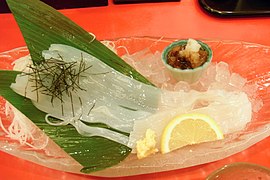Ika sōmen


Ika sōmen (イカそうめん,
It is considered a specialty of Hokkaido, especially Hakodate, a fishing port where large catches of squid are hauled, though this regional notion has been challenged by availability in wider markets driven by commercialism.[3]
Nomenclature
[edit]The ika sōmen is not sashimi according to some sources, one such culinary reference making the comparison that while the squid is suited for the ika sōmen, the thicker-fleshed cuttlefish is more palatable for making into sashimi.[4] However, it has also been pointed out that ika sōmen is synonymous with ito-zukuri[5] or "thread cut", which is a technique in sashimi-slicing.[6]
The name gained currency only in modern times. Hokkaido native and author Junichi Watanabe remarked in Kore wo tabe nakya—watashi no shokumotsushi ("Gotta eat this, my food history", 1995) that the term ika sōmen came into popular use only recently, adding that it is "nothing more than thinly sliced squid sashimi".[7] In 1970, poet Kusumoto Kenkichi described a dish identical to ika sōmen ("a bowl (donburi) full of raw squid sliced like tokoroten noodles, with grated ginger and soy sauce") but mentioned that it went by the nickname umi no sōmen or "sōmen noodles of the sea".[8][9][a]
Preparation
[edit]The squid's fillet is cut into half (or into thirds) and then into strips. Some cookbooks insist that the strips must be cut vertically along the "length of the squid along the grain" to prevent it from becoming overly chewy.[1] The name suggests the strips resemble sōmen, i.e., as thin as vermicelli.[1][4] Even though some sources take this literally,[11] the description above likening it to "tokoroten" noodles[8] suggest thicker strips, as do recipes that call for "5 mm (0.20 in) widths".[12]
The typical way it is served is to have these "noodles" heaped in a bowl (donburi),[8][11] accompanied by grated ginger and soy sauce,[1][4] or a soy sauce-based noodle sauce, called mentsuyu.[11] Lately, it may also be served on a flat dish even in Hakodate, Hokkaido,[11] and eaten with wasabi and soy sauce,[12] which is then no different from squid sashimi ito-zukuri style.[5][6]
At port towns where the caught squid are brought ashore, the freshly caught squid are semi-translucent,[2] have excellent texture, and are "marvelously sweet, especially the morning-caught squid shipped alive".[2]
In Japan, the abundantly caught surume ika or Japanese flying squid, available from early summer onwards, is used to make this dish.[2][11][13] In practice, other (more expensive) squid species are sometimes substituted, such as the yari ika (Loligo bleekeri) or the aori ika (bigfin reef squid).
The ika sōmen has also become widely available prepacked in Japan.
As with uncooked seafood in general (see Sashimi#Safety), eating this dish made from raw untreated squid poses some risk of contracting anisakiasis, since the parasite when present in the animal infests the flesh of its body (mantle).[14]
See also
[edit]Footnotes
[edit]Explanatory notes
[edit]- ^ Note that umi sōmen is the traditional name for the eggs of the gastropod known as amefurashi (sea hares), a delicacy of Inaba Province (Tottori Prefecture). Cf. Tōson Shimazaki eating experience in the Uradome Coast, Tottori.[10]
Citations
[edit]- ^ a b c d e Matsuhisa, Nobuyuki (2001), Nobu: The Cookbook, Kodansha International, pp. 80, 195, ISBN 4770025335
- ^ a b c d
上村 ,一真 (Uemura, Kazumasa) (2008), ローカル魚 で絶品 ごはん (Rōkaru sakana de zeppin gohan), Ei Publishing, pp. 31–32, ISBN 978-4777910731{{citation}}: CS1 maint: multiple names: authors list (link) - ^ Hayes, Dayle; Laudan, Rachel (2009). "Japanese cuisine". Food and Nutrition: Grains to legumes. Marshall Cavendish. p. 599. ISBN 978-0-7614-7817-1.
- ^ a b c Davidson, Alan (2002), The Penguin Companion to Food, Penguin Reference, p. 900, ISBN 0142001635
- ^ a b
山口 ,百々 男 (Yamaguchi, Momoo); Bates, Steven (2014),和英 :日本 の文化 ・観光 ・歴史 辞典 (The Japanese-English Dictionary of Culture, Tourism and History of Japan),三修社 , p. 25, ISBN 978-4384051834{{citation}}: CS1 maint: multiple names: authors list (link) - ^ a b Downer, Lesley (2001), At the Japanese Table: New and Traditional Recipes, Chronicle Books, p. 54, ISBN 0811832805
- ^
川端 ,晶子 (Kawabata, Akiko);淵上 ,匠 子 (Fuchigami, Shoko) (2006), おいしさの表現 辞典 (Oishisa no hyōgen jiten), Tokyodō Shuppan, p. 151, ISBN 9784490106947{{citation}}: CS1 maint: multiple names: authors list (link) - ^ a b c
楠本 ,憲吉 (Kusumoto, Kenkichi) (1970), たべもの歲時記 (Tabemono saijiki), Yomiuri Shimbunsha, p. 235{{citation}}: CS1 maint: multiple names: authors list (link) - ^
全国 の物産 と産業 (Zenkoku no bussan to sangyō),通産 企画 調査 会 (Tsūsan kikaku chōsakai), 1984, p. 22,朝 イカの刺身 は「海 のそうめん」と呼 ばれ食通 にはこたえられない - ^
島崎 ,藤村 (Shimazaki, Tōson) (1929). "山陰 土産 (San'in miyage)".藤村 紀行 文集 (Anthology of Tōson travelogues). Kaizōsha.{{cite book}}: CS1 maint: multiple names: authors list (link)) - ^ a b c d e
成瀬 , 宇平 (Naruse, Uhei) (2011), 47都道府県 ・魚 食 文化 百科 (47 todōfuken gyoshoku bunka hyakka), Maruzen, p. 44, ISBN 978-4621084069{{citation}}: CS1 maint: multiple names: authors list (link) - ^ a b
久保 ,香 菜子 (Kubo, Kanako) (2008),基本 がきちんと身 につく!お料理 の教科書 (Kihon ga kichin to mi ni tsuku! Oryōri no kyōkasho), Ei Publishing, p. 27, ISBN 978-4777910731{{citation}}: CS1 maint: multiple names: authors list (link) - ^
小沼 ,明美 (Onuma Akemi) (2013), いかの種類 と旬 , AllAbout,日本 で一番 とれるこのいかは、函館 名物 いかそうめんに使 われます - ^
村田 , 以和夫 (Murata, Iwao) (2003). "アニサキス症 と天然 物 由来 の有効 化学 物質 の検索 (Anisakiasis and The Screening of Larvicidal Compounds from the Nature Remedies for Anisakis simplex)".東京 健 安 研 セ年報 (Ann. Rep. Tokyo Metr. Inst. PH). 54: 4.スルメイカは2~24 %
台 と寄生 率 は他 の魚介 類 より低率 であるが,外套 膜 筋肉 中 の可 食 部分 から全 て検出 されたもので,イカ刺 ・イカそーめん等 調理 法 による感染 の危険 性 は高 い{{cite journal}}: CS1 maint: multiple names: authors list (link)
External links
[edit] Media related to Ika somen at Wikimedia Commons
Media related to Ika somen at Wikimedia Commons
